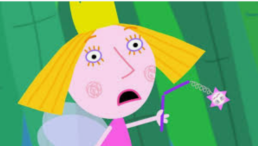A Winner Is ...
… just a loser who tried one more time. George Leonard, in his book Mastery, reminds us that it may take many steps to arrive at a destination. That might look like two steps forward and one step back, or even one step forward and three steps back. The key is realizing the steps backward or even the long plateaus with no advancement are not reasons to quit.
People with attention deficit disorder are likely to try things that are new and exciting, but when they become boring or difficult, well... I took lessons in guitar, clarinet, piano, and flute and can play nary a one because I gave up at the plateau. If I realized then that a plateau was a great time for integration, I might play a musical instrument today.
Working towards goals may mean developing new habits that are not immediately comfortable. A plateau gives you time to acclimate and work that habit into your mindset as well as your routine.
 Back steps are opportunities for evaluation. You might check to see if you’re on the “right path” for the “right reason,” and using the “right approach.” Everyone finds themselves doing something that doesn’t feel great. That’s a time to check in with your what, why, and how of the thing to make sure you are being true to your values.
Back steps are opportunities for evaluation. You might check to see if you’re on the “right path” for the “right reason,” and using the “right approach.” Everyone finds themselves doing something that doesn’t feel great. That’s a time to check in with your what, why, and how of the thing to make sure you are being true to your values.
Think about a goal you have for 2021. How committed are you to achieving it? Remember the quote by John Assaraf: “If you’re interested, you will do what is convenient; if you’re committed, you’ll do whatever it takes.”
Need help? Here I am.
- Sydney Metrick
Too Many Choices?
Is your task list overwhelming? Can’t decide where to start? Would you rather just relax under a leafy tree and enjoy nature?
Forget the leafy tree and start using a decision tree.
In simple terms, a decision tree is a series of simple questions with instructions based on each answer. They can help you differentiate each task, the actions to accomplish it, and the possible results of the actions. Seeing future results of actions makes it easier to choose a direction and steps.
The decision tree may help you design the week ahead, or help with the steps of a project, or even plan a shopping trip. I even have one client who used to use a decision tree before leaving the house because what she needed to take with her depended on what day of the week it was.
Depending on the situation decision trees can range from incredibly simple (my client just had several PostIt Notes on her door asking questions) to extremely complex. While the complex ones can look scary, they really do simplify things because you just follow the path of your answers. The hardest part is sitting down the first time to figure out the steps, then you just have them.
 For example, after moving to Mexico, I posted a decision tree on my bulletin board to help me learn how to make local- and long-distance phone calls. Let’s say I want to make a call:
For example, after moving to Mexico, I posted a decision tree on my bulletin board to help me learn how to make local- and long-distance phone calls. Let’s say I want to make a call:
Is the call from a land line or mobile? >Mobile.
Is it to a land line or mobile? >Land line.
Is the call local or long distance? >Long distance.
Within Mexico or abroad? Etc. Eventually, the questions lead to the correct numbers for the call.
It helps to draw the tree and even use color for different categories, tasks, or types of answers. And, your tree can grow! If you find a new answer to one of your questions, just add a branch!
Need help? Here I am.
Back to the Future
As I just had a birthday, I reviewed the past mumble mumble years, and thought about what I wanted to be about in my year ahead. What better way to plan for future goals than to work with the Goal Planning Form I used with students in the “Organize Your Life” classes.
Here it is:
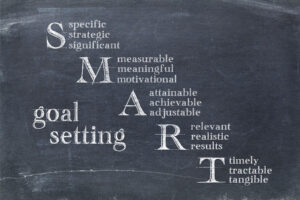 What is your SMART goal?
What is your SMART goal?
- Specific-what do you specifically want to accomplish
- Measurable-how will you know you’ve achieved it?
- Achievable-can a person do this?
- Realistic- can you do this with the time and materials available?
- Time phased-by when will you achieve your goal?
- Does this goal support or conflict with your values? (Do you know your top values, the things that give you satisfaction?)
- Is it worth the time, effort, and expense?
- How will you benefit from achieving this goal? Or What problems will you avoid by achieving this goal?
- Imagine what your life will be like once you’ve achieved your goal.
- What are some possible internal or external obstacles that might come up? What might be some solutions to these obstacles?
- What are the specific actions you will take and when will you take them?
Need help? Here I am.
- Sydney Metrick
What, Me Worry?
 There’s a good chance that your worry and anxiety have gone up a few notches this past year. In addition to the overwhelm you may experience in your personal life, we have a pandemic in an election year, and terrible things happening climate-wise in various parts of the country and the world.
There’s a good chance that your worry and anxiety have gone up a few notches this past year. In addition to the overwhelm you may experience in your personal life, we have a pandemic in an election year, and terrible things happening climate-wise in various parts of the country and the world.
Though you still may take action to make a difference, there’s only so much you can do on a grand scale. Your greatest power lies in your personal life, where you can change YOUR beliefs and YOUR habits around dealing with everything that is going on.
Unfortunately, some of the stories you tell yourself about who you are and what you can truly achieve come from misguided attempts to keep you safe. Based on fears and insecurities your inner saboteur will say, “you can’t,” “you’re not,” “you shouldn’t” and flood you with feelings that prevent you from doing and being what’s important for you.
When you repeatedly tell yourself something is difficult, you don’t have time, or anything that diminishes you, it becomes your reality. To create a different reality, interrupt that inner saboteur and tell yourself something different.
Catch yourself. Change your words. Change your story. Start to change your life.
Need help? Here I am.
-Sydney Metrick
How Urgent is it?
Are you more effective at getting things done when there’s a sense of urgency? Does the day before a deadline provide the impetus that seemed to be lacking in the previous days?
 If you wait until the last minute you may actually be more motivated to perform the task than if you’d started earlier on. In that final day or moments, your brain is suddenly kick-started. Urgency wakes up your brain.
If you wait until the last minute you may actually be more motivated to perform the task than if you’d started earlier on. In that final day or moments, your brain is suddenly kick-started. Urgency wakes up your brain.
On the other hand, when you have a task that you find really interesting, rather than just required, you’re way more likely to address it in a timely fashion. Interesting things also wake up your brain. Think “I get to” versus “I have to” and note the difference in how you feel.
If urgency is your habitual way of responding you might also find yourself feeling anxious, overwhelmed, and wiped out. Responding to emergencies and crises can be exhausting.
So, what can you do to prevent being in crisis mode? How do you take care of important things in a timely fashion? Preventing frequent crises means first learning from them. That way you can plan and prepare. “Yes but …,” you may be thinking. What about that lethargic brain? Here’s where mini-deadlines can save the day.
Break up your project or whatever it is that needs doing into small bits. Maybe it’s writing just one page each day for a presentation that’s two weeks away, or going through just one box a day to clear your storage space. Or it could be a time chunk, like scheduling just 30 minutes for a task each day. Give yourself a daily deadline.
Because a deadline doesn’t always count without accountability, have someone ask for status checks regularly.
The finished project is the sum of the bits, so think about how many bits you’ll need in all so you can determine your start date.
Need help? Here I am.
-Sydney Metrick
Designing an Uncertain Future?
Have you heard anyone talk about “when things return to normal” or possibly “we are moving to ‘a new normal’”? Normal is defined as usual or typical.
Normal is a problematic concept in a number of ways because it is “in the eye of the beholder” and influenced by other problematic concepts like:
- Habits
- Self-concept
- The future
 When you do or think something repeatedly over time it becomes a habit. You may recall the four-step grid for developing a new habit. It starts with the awareness that what you are doing isn’t working for you in the present. That’s Unconscious incompetence. Working on a new behavior can be challenging—conscious incompetence. As the new behavior begins to become a regular activity it’s conscious competence. Finally, it’s so ingrained that you become unconsciously competent. With habits, normal is generally unconscious.
When you do or think something repeatedly over time it becomes a habit. You may recall the four-step grid for developing a new habit. It starts with the awareness that what you are doing isn’t working for you in the present. That’s Unconscious incompetence. Working on a new behavior can be challenging—conscious incompetence. As the new behavior begins to become a regular activity it’s conscious competence. Finally, it’s so ingrained that you become unconsciously competent. With habits, normal is generally unconscious.
Your self-concept is tied to beliefs and habits. You hold beliefs about yourself that influence your actions. As your actions or behaviors change your image of yourself shifts. How you previously saw the way you were as normal for you might be quite different with new behaviors.
Your future exists in your imagination. We also have collectively imagined futures, like space colonies and cures for diseases. These imaginings can become goals and perhaps come to pass. But you never really can predict what, if, or when.
The “solution” for your definition of normal is to imagine what you’d realistically like life to look like over the next months, or years, and do what you can to make that happen.
-Sydney Metrick
Who’s Running your Life?
Do you have any “should do’s” interrupting your days? “Shoulds” are typically things around health, e.g. have a healthier diet, or exercise more. They may involve organizing, such as “I should put away the laundry, clean out the refrigerator, get rid of all those emails in my inbox.”
 One psychology model suggests we have three ego states: parent, adult, and child. The parent state, associated with the likes of teachers and bosses as well as parents is responsible for the “shoulds”. The parent state diminishes your authority and often is the source of procrastination. In fact, a resistant childlike response may take over.
One psychology model suggests we have three ego states: parent, adult, and child. The parent state, associated with the likes of teachers and bosses as well as parents is responsible for the “shoulds”. The parent state diminishes your authority and often is the source of procrastination. In fact, a resistant childlike response may take over.
This is most likely if your internal parent voice is critical.
Your child state, on the other hand, can often accomplish things by making them fun or interesting. Finally, your adult state does what needs doing because it makes sense.
The inner adult is likely to have the most developed critical thinking skills. For example, your inner adult would like to improve your diet for specific reasons. For those reasons, you can identify the appropriate healthier diet for you, as well as a realistically put it into place. In time, your inner adult would evaluate how the plan is working and make any needed changes.
Working on the theory that everything is there for a reason, the inner parent does have value. The parent state represents the rules that we’ve adopted as guides. Sometimes those rules can be critical, but it is also where our morals and confidence stem from.
- Sydney Metrick
How to Make a Not “to do” List
Do you get lost in the sea of Post-it® notes and lists of things you want to remember? I have all sorts of lists. One for the appointments for the month including: medical appointments for the family, quarterly home repairs and upkeep, newsletter ideas, and possible projects. Then there is the shopping list, basic reminder list, calls to return list, and so on.
Sounds like lots of lists doesn’t it?
Keeping up with all the items on all the lists is challenging and time-consuming. My solution is to basically outline each week. I gather all my lists and prepare to make another list! I first create headings, e.g. medical, garden, repairs, calls. Next, I look at the tasks in each “big picture” list and consider what is necessary to address in the week ahead. I then prioritize those necessary items. Yes, it is necessary to do laundry. But how does it rank against transplanting that dying bush, or organizing the coat closet by season?
 At that point, I can get rid of some of the excess Post-it notes that I’ve managed to consolidate.
At that point, I can get rid of some of the excess Post-it notes that I’ve managed to consolidate.
Prioritizing is where some people foil themselves. It can be easy to assign a lower priority to the tedious, or less fun, items – even when they are the ones that need doing. (I know that I, personally, prefer to dress in my bedroom, not in front of the dryer.)
Have you considered a Not To Do list? Consider all those items that you think you “ought” to do, like alphabetizing your pantry, yet have no relevance to your current goals and lifestyle. Put them all on one big Not To Do list. Then put the list away so that its contents cannot distract you. Look the list over every few months. Some items may gain enough importance to move to your To Do list, and that’s when you will actually do them.
In the meantime, for those tasks that you do not enjoy yet acknowledge need doing, try working on them in short bursts, alternating them with more enjoyable items, or set up a reward for when you can cross it off your list.
-Sydney Metrick
We’ve Been Forced to Change
Having to shelter in place drives home Newton’s first law, known as the law of inertia. You may wonder how this applies to you. The law says an object at rest stays at rest and an object in motion stays in motion – with the same speed and in the same direction unless something pushes or pulls it. Basically, as objects, we don’t change our behaviors just because it’s a good idea. It might make sense to change, but oh the effort you feel you must expend.
When you don’t seem to have any choice in the matter, most of you will comply and find ways to make changes. You might do it kicking and screaming, or you might get creative. The bottom line is you can, and you do, learn to do things differently. If the past ways are no longer working, you get to look for ways to create a different and even better present and future.
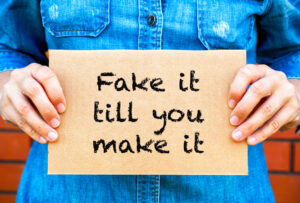 This is applicable across the board. No need to adhere to old habits that don’t work just because you’ve always done things that way, and it’s easier to just follow that beaten path.
This is applicable across the board. No need to adhere to old habits that don’t work just because you’ve always done things that way, and it’s easier to just follow that beaten path.
Think of a change you say you want to make. What’s stopped you? Lack of time, knowledge, remembering, fear of failure, a story about how difficult it will be? Is the change really important to you? On a scale of zero to ten, how important?
If the new behavior feels really important and you have the time, materials, and/or tools what else do you need? Commitment? Accountability? Knowing what the first step is and how you will take it?
Guess what? It’s all in your head! You know the terms “live as if,” and “fake it ‘til you make it”? Well, those things work because the brain sees imagined truth just like truth.
Here’s a way to start:
- Imagine the time in the near future when your desired change is in place and you feel great.
- Spend a few minutes daily (or throughout the day) imagining yourself doing the things that make the change happen and then being in that imaginary future in which it has occurred.
The more you practice mentally, the easier it becomes in actuality. In fact, the mental practice will help make the actuality happen.
-Sydney Metrick
Are You Time Blind?
How far away is later? Especially to those with ADHD, later is somewhere out there. Maybe later actually has a time and date, but remembering what that time and date is, or even what today is, may be somewhat of a challenge.
Do you have any of these issues? Finding it difficult to estimate how long something might take, or lack of awareness of how much time has passed and suddenly you’re “out of time”?
It’s possible that you have a short time horizon. Think about how a child will ask, “is it tomorrow yet,” or similar questions along those lines. As we grow up typically our time horizon expands and we can make future plans…unless you are time blind.
Creating timelines, especially visual ones, can be really helpful. A simple timeline is a map. You know where you are and you have an idea of where you want to go. Timelines are common, and can look intimidating, in project management. The trick is to be able to break things down into manageable bits. It also helps to understand the order of those bits; let’s say you want to take a bath, you fill the tub, bathe, and then empty the tub. Fill, empty, then bathe doesn’t work.
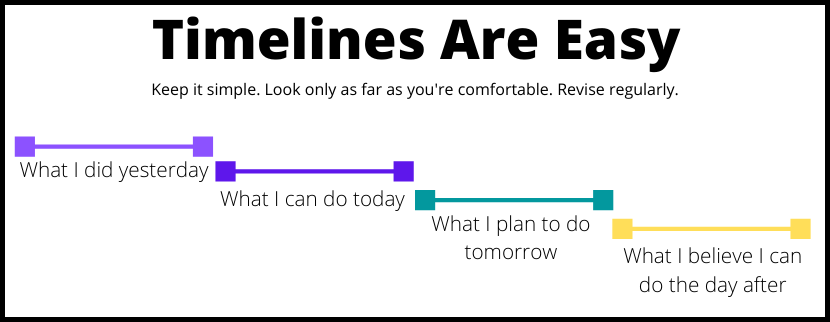
For example, when my husband and I drove down from the San Francisco Bay area to our current home outside of Guadalajara, Mexico, I first had to look up the best route and how many miles we’d be driving. Then I calculated how many miles we could manage each day including rest stops and a little padding for emergencies. Next, I looked for dog-friendly motels along our route and made reservations.
Each day included some recalculation depending on various unknown factors, but the day by day planning and review made our trip a success.
If you can’t see far into the future, think about what you did yesterday and can do today. You can then project forward day by day and week by week, refining with each review.
Failing Successfully
Did you know that failure is an “Essential Prerequisite” to success? At least, that’s what scientists who studied a massive amount of data concluded and Scientific American reported on.
Chances are you’re familiar with Kentucky Fried Chicken, now known as KFC. Did you know that Colonel Harland Sanders, the Kentucky Colonel whose face graces every “finger lickin’ good” bucket of chicken, was nearly a lifelong failure? At age 65 he took a stand for his famous chicken recipe and was rejected by over 1000 restaurants before it finally sold. The rest, as they say, is history.
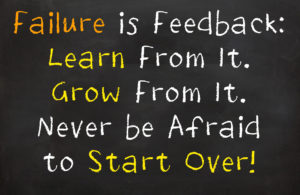 Jim Carrey, J.K. Rowling, and Oprah Winfrey are others who experienced failure and hardship before making it. It wasn’t luck that brought them to their successes. Success comes from several factors: learning from what works and what doesn’t, making corrections, and committed perseverance. You may have previously read one of my favorite quotes by John Assaraf, “If you’re interested, you’ll do what’s convenient; if you’re committed, you’ll do whatever it takes.”
Jim Carrey, J.K. Rowling, and Oprah Winfrey are others who experienced failure and hardship before making it. It wasn’t luck that brought them to their successes. Success comes from several factors: learning from what works and what doesn’t, making corrections, and committed perseverance. You may have previously read one of my favorite quotes by John Assaraf, “If you’re interested, you’ll do what’s convenient; if you’re committed, you’ll do whatever it takes.”
Failure gifts us with lessons and direction. Make sure your failures don’t lead you to a seat on the pity pot. When an attempt fails, figure out how and why, don’t be afraid to ask for support, and try again. That’s something else those scientists realized, success became more likely – and came more quickly – to those who got right back to work. That seat on the pity pot is more than unproductive, the longer you sit on it the more likely your next attempt is also going to fail.
The 5 Second Procrastination Cure
A friend recently told me she heard about a five second rule that supposedly helps you fight the urge to procrastinate - a procrastination cure, apparently. A bit skeptical, I procrastinated on finding out more about the rule. Eventually, I got around to learning the rule. It goes like this: when you tell yourself it’s time to [insert chore here], you have five seconds before your brain says, “ah forget about it.” If you count backwards from five to one, your brain is supposed to stay motivated and get you going. Mel Robbins, author of this 5 Second Rule, explains it all in her blog The Five Elements of the 5 Second Rule.
Maybe this will work for you. If so, great! If not, no worries. There really are no solid “cures” for procrastination. Some people argue that the only reason people procrastinate is because of stress – we want to avoid the bad feeling associated with the task. However, there are other reasons we put off tasks:
- Not knowing where or how to start.
- Values conflict.
- The task requires more time than is currently available.
- An emergency or other distraction comes up between preparing for and beginning the task.
Your procrastination may have valid reasons; just make sure you address those reasons – figure out where to start, schedule the time necessary, etc.
 However, when you’re running behind and need to finish something that you have been avoiding, here are some solutions you may find helpful.
However, when you’re running behind and need to finish something that you have been avoiding, here are some solutions you may find helpful.
- If keeping your word is important to you, promise someone that you will complete the task – and have them hold you accountable.
- Pair the task with something you enjoy such as listening to music or having a friend over to provide encouragement.
- Work on the task for a manageable chunk of time. It is amazing what you can do in 20 minutes.
- Schedule it before something you’re looking forward to doing, e.g. Go for a bike ride as soon as you finish ten minutes of filing the papers on your desk.
You might even decide to work with a coach.
-Sydney Metrick
Now versus Later
The brain only knows now. This is where we are, this is what we focus on.
Many people can become so involved in what they are currently working on that thoughts of what was done or what is to be done never come up. Being able to completely focus on only one aspect of now frequently happens when, and is beneficial for, project work, studying, or meditation.
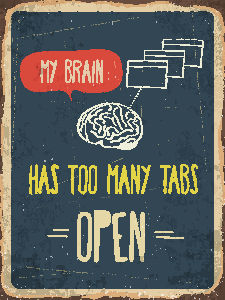 However, on the other side of the proverbial coin, there are people so easily distracted by past or future thoughts, ideas, needs, or tasks that staying focused on one immediate task can be difficult. This happens when the brain cannot filter every other aspect of now from the task at hand.
However, on the other side of the proverbial coin, there are people so easily distracted by past or future thoughts, ideas, needs, or tasks that staying focused on one immediate task can be difficult. This happens when the brain cannot filter every other aspect of now from the task at hand.
When you live in the unfiltered now, your mind has a myriad of things swimming around in it rather than just one. This might mean that you miss due dates, run late, or have more things started than completed.
For those of us who are not linear thinkers, we often have a number of ideas, thoughts, and “to-do’s” all vying for attention. Besides being distracting, this can make it difficult to pick a task to work on, let alone focus on it. When you are confronting the various “must do’s” in every category of your life (work, home, health, family, and so on), give importance to deadlines and items you have already identified as having higher priority.
I have a deadline for getting out two monthly newsletters. I open a blank doc for each at the beginning of the month and write in thoughts and ideas as they come to me. By the last week of the month, I commit to organizing a first draft. Typically, I’ll re-read and edit in a few days. Because I have a short attention span this works for me. It’s the small chunks idea.
I’m successful at getting these newsletters out because I’ve come up with a process that works for me. Plus, I’m committed to the recipients of my newsletters and I value commitment.
Finding systems that work for you can be challenging. Perhaps prioritizing, setting deadlines for small bits, and making a commitment is the process for you. Give it a go.
-Sydney Metrick
What is Your “Too Much”?
Do you find it hard to think when you’re in a noisy environment? Do certain fabrics against your skin, or labels in your shirt drive you up the wall? Can the smell of someone’s cologne or aftershave make you want to leave the room?
When people think of ADHD and filters, they tend to consider only the filters that keep inappropriate things from coming out of our mouths. Rarely do they consider filtering inputs, or our inability to filter inputs.
 ADHD or not, for those of us lacking good filters, sensory experiences - be they seeing, hearing, touch, smell or taste - are sometimes difficult to bear. In fact, having a label in your shirt that rubs against your neck might be so distracting that it’s all you can focus on. The proximity and number of people in a crowd might feel really uncomfortable.
ADHD or not, for those of us lacking good filters, sensory experiences - be they seeing, hearing, touch, smell or taste - are sometimes difficult to bear. In fact, having a label in your shirt that rubs against your neck might be so distracting that it’s all you can focus on. The proximity and number of people in a crowd might feel really uncomfortable.
Not everyone can tune out distractions in whatever form they might be presented. Not being able to filter input or create boundaries leads to overstimulation. That’s one reason why most of the people I’ve worked with describe themselves as overwhelmed.
While you may not be able to create filters, you can develop boundaries. In loud or crowded environments find a quiet corner, or give yourself permission to leave when you feel anxious. At home or work limit noise. Use earplugs or headphones when you can. Cut those itchy labels out of your clothes and wear fabrics you enjoy—typically natural fibers feel better. Buy fragrance-free products.
Finally, take a break. If you need alone time or quiet periods during the day, schedule them in.
What’s Your Name Again?
Does this ever happen to you? You’re at an event and get introduced to someone and find their name is gone almost as soon as you hear it. This is common for those of us with short-term or working memory challenges. Perhaps you go to the store to pick up a few items, let’s say coffee, cereal, and juice. While holding the cereal and juice you run into an acquaintance and have a brief conversation. Paying for your items and arriving back home you realize you totally forgot the coffee.
 When I was teaching, a pop-up thought would sometimes arise related to the subject, or a student would ask something that stimulated another relevant concept. Knowing I’d be likely to completely forget those random thoughts, I trained myself to make a small note on my lesson or the whiteboard.
When I was teaching, a pop-up thought would sometimes arise related to the subject, or a student would ask something that stimulated another relevant concept. Knowing I’d be likely to completely forget those random thoughts, I trained myself to make a small note on my lesson or the whiteboard.
Meetings were also a problem for me. I used to blurt out random thoughts – rudely interrupting – afraid of losing them. Finally, I realized that making a note of my thought was a much safer way of preserving my ideas.
The most annoying problem for me was putting something important in a “safe place” and then having no idea where that place was. I finally realized that it’s much easier to have a few safe places that I used every time. Even then I started putting notes in my calendar saying something like, “find check for Fri. appt. w/kitchen knives.”
Little reminder notes work well for me. Lists for shopping help lots. Many people find that their phones are great places for lists and reminders – others just find them annoying.
As for names, the best I’ve come up with is, “Sorry, I just spaced out on your name.”
-Sydney Metrick
Let’s Find Your Motivation
Do you sometimes find it hard to get motivated for an important task? Could it be you don’t find the task interesting?
There are two types of motivation—internal and external. When you do something to receive a reward or avoid some sort of “punishment” it’s because you’re externally motivated. The problem, in this case, is that when the motivator is no longer there the motivation wanes.
On the other hand, when you are internally motivated to perform a task you likely find it interesting, enjoyable, or satisfying in some way. So, what if, say, organizing a room is not fun or interesting to you. How could you get yourself to do it?

Possible solutions:
- Pair the task with something you enjoy. For example, put on 20 minutes of your favorite music and organize during that time.
- Get a body double. That’s someone who will sit with you, or even help out, while you work on your task.
- Look at your values. If you value integrity, tell someone what you’ll be doing and when you’ll do it. Then, have them ask you how it went.
- Perhaps you value competition. Set up a game with a friend or family member to see who gets their task accomplished first.
There are many ways to make your task interesting or meaningful. A good place to start is with your mindset; “I get to” things tends to be much more fun than “I have to” things.
-Sydney Metrick











